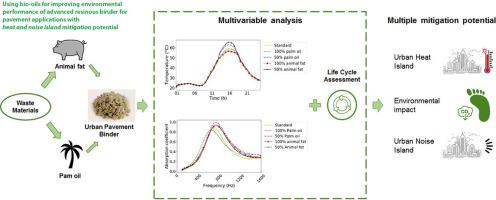Sustainable Energy Technologies and Assessments ( IF 8 ) Pub Date : 2020-04-28 , DOI: 10.1016/j.seta.2020.100706 Ioannis Kousis , Claudia Fabiani , Luca Ercolanoni , Anna Laura Pisello

|
Urbanization and actions are responsible for overheated cities compared to the adjacent rural settings, a phenomenon known as Urban Heat Island (UHI). Additionally, conventional urban materials contribute towards the aggravation of urban noise pollution, a phenomenon that may be described as Urban Noise Island (UNI). Numerous solutions have been proposed through the implementation of novel, more sustainable, or natural materials in the pavement infrastructure. To that end, this study bridges the gap between UHI and UNI mitigation strategies, simultaneously ensuring low environmental impact. Therefore, a resin-based pavement binder was investigated through multiphysics analysis, together with four innovative binders made with waste bio-oils. Thermal, optical, acoustical and Life Cycle Assessment analysis were carried out for gauging the UHI/UNI mitigation potential of binders and their environmental impact. Results showed that the innovative binders preserved good physical properties: all binders have solar reflectance higher than 50% within 750–1600 nm range and sound absorption coefficient higher than 0.8 within 600–800 Hz. Additionally, bio-oils decreased the environmental impact of the binder up to 37.46mPt, and 8.33% in the ReCiPe, and Intergovernmental Panel on Climate Change analysis, respectively. Therefore, the exploitation of bio-oils in the pavement market can be considered as promising green solution for mitigating both UHI and UNI.
中文翻译:

使用生物油改善用于道路应用的高级树脂粘合剂的环境性能,具有缓解热和噪音的潜力
与邻近的农村环境相比,城市化和行动是造成城市过热的原因,这种现象被称为城市热岛(UHI)。此外,传统的城市材料也加剧了城市噪声污染,这种现象可称为城市噪声岛(UNI)。通过在路面基础设施中实施新颖,更具可持续性或天然材料,提出了许多解决方案。为此,本研究弥合了UHI和UNI缓解策略之间的差距,同时确保了对环境的低影响。因此,通过多物理场分析研究了一种树脂基路面粘结剂,以及四种由废弃生物油制成的创新粘结剂。散热,光学,进行了声学和生命周期评估分析,以评估粘合剂的UHI / UNI缓解潜力及其对环境的影响。结果表明,创新的粘合剂保留了良好的物理性能:所有粘合剂在750–1600 nm范围内的太阳反射率均高于50%,在600–800 Hz范围内的吸声系数高于0.8。此外,在ReCiPe和政府间气候变化专门委员会的分析中,生物油将粘合剂对环境的影响分别降低至37.46mPt和8.33%。因此,在人行道市场上开发生物油可以被认为是缓解UHI和UNI的有前途的绿色解决方案。所有粘合剂在750–1600 nm范围内的太阳反射率均高于50%,在600–800 Hz范围内的吸声系数高于0.8。此外,在ReCiPe和政府间气候变化专门委员会的分析中,生物油将粘合剂对环境的影响分别降低至37.46mPt和8.33%。因此,在人行道市场上开发生物油可以被认为是缓解UHI和UNI的有前途的绿色解决方案。所有粘合剂在750–1600 nm范围内的太阳反射率均高于50%,在600–800 Hz范围内的吸声系数高于0.8。此外,在ReCiPe和政府间气候变化专门委员会的分析中,生物油将粘合剂对环境的影响分别降低至37.46mPt和8.33%。因此,在人行道市场上开发生物油可以被认为是缓解UHI和UNI的有前途的绿色解决方案。


























 京公网安备 11010802027423号
京公网安备 11010802027423号